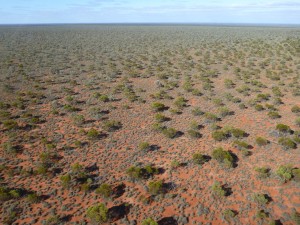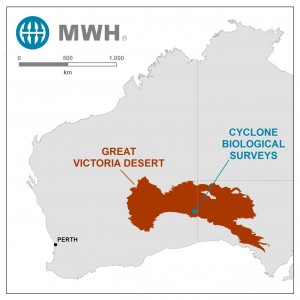MWH added another substantial project to its remote area biological survey portfolio in 2014, with the safe and successful completion of biological surveys for the Lost Sands Cyclone Mineral Sands Project. The Cyclone Project is in the Great Victoria Desert, adjacent to the Western Australian border and approximately 1,500 km from Perth.
The Great Victoria Desert is Australia’s largest desert and contains some of the most remote locations in the country. Very little road infrastructure is present, and no substantial settlements exist to serve as bases of operation. The area is so remote that in order to conduct the baseline flora and fauna surveys MWH set up its own self-sufficient base camp, and operated for weeks at a time using only helicopters for transport instead of ground-based vehicles. The surveys were successfully completed, with the field zoologists and botanists obtaining all necessary information for Lost Sands to proceed with their environmental approvals, and with no harm to personnel, equipment or the sensitive environments of the Great Victoria Desert.
The safe and efficient completion of the surveys was a testament to the detailed planning performed by MWH field scientists, and the result of teamwork between MWH, Lost Sands and traditional owners. MWH consulted extensively with Lost Sands and representatives from the local traditional owner group, the Pila Nguru (Spinifex People), in acknowledgement of the benefits of on-ground, local knowledge for improving logistics management and indigenous ecological knowledge for improving scientific outcomes.

The Great Victoria Desert is vast, remote and largely without road access infrastructure
Photo: Mike Young
The biological surveys have made a substantial contribution to our knowledge of the Great Victoria Desert. Little is understood about the ecology of this area, due largely to its remote nature. Recognising this, the Western Australian Department of Parks and Wildlife and the Great Victoria Desert Biodiversity Trust recently hosted a series of workshops in order to identify research and management priorities for the region. Due to the unique, on-ground experience of its scientists, MWH was able to materially contribute to these workshops by way of scientific presentations.
If you have a need for safe, efficient and rigorous remote area biological surveys anywhere in Australia, MWH can assist. For more details contact the Terrestrial Ecology discipline lead, Dr Blair Parsons, on (08) 9388 8799 or at blair.parsons@mwhglobal.com.
Helicopter Photo Credit (previous page): Arnold Slabber

